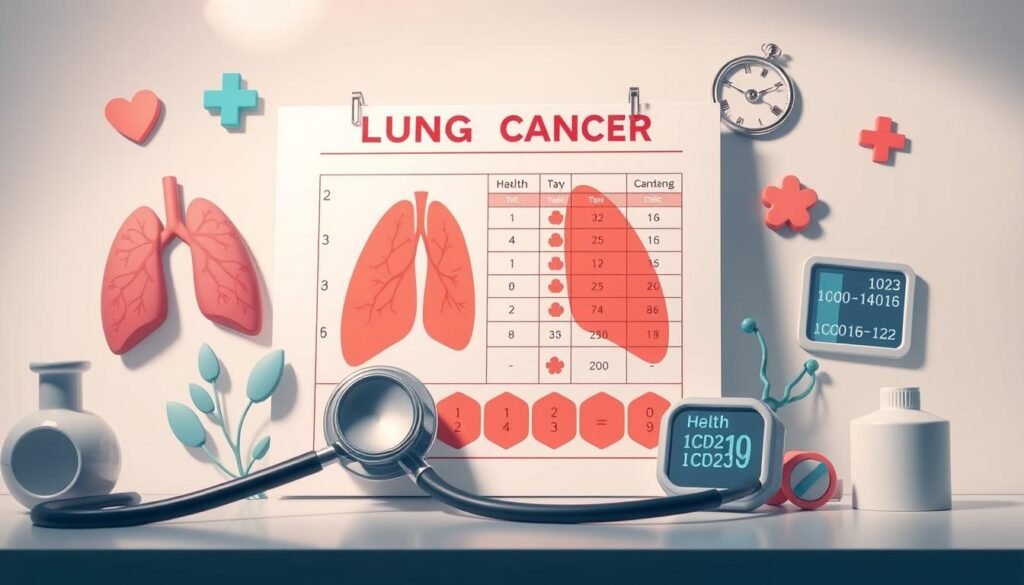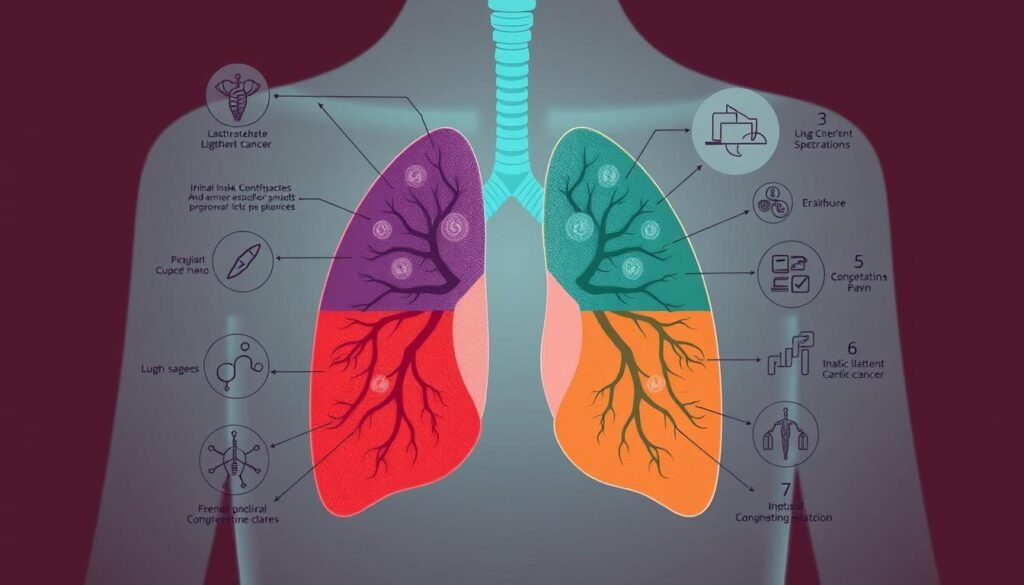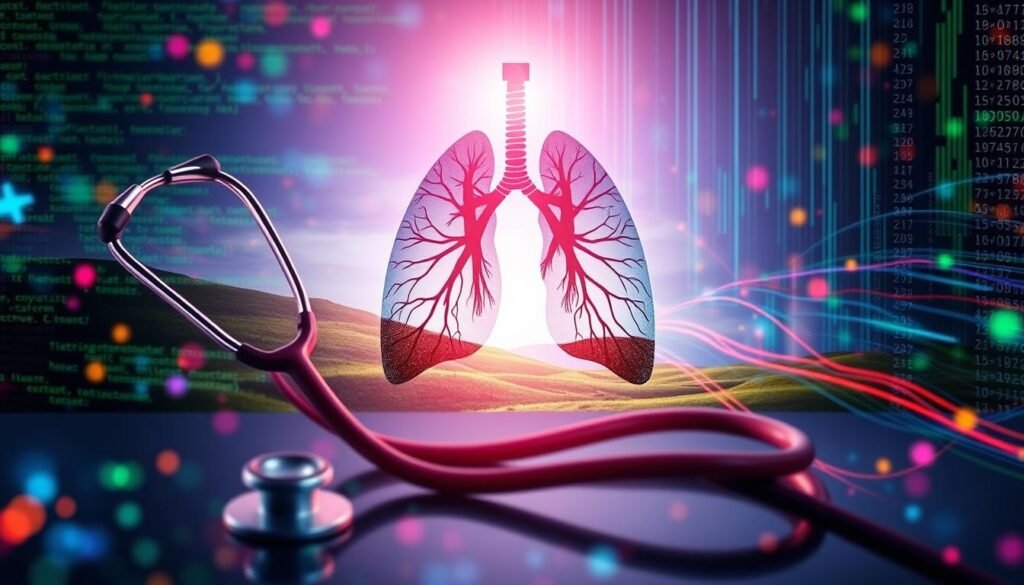The ICD-10 coding system classifies various lung cancer types clearly. It makes differences between lung parts like the main bronchus and upper lobe clear. Non-small cell lung cancer is the most common type. So, accurate coding is very important for good patient care. This guide talks about ICD-10 codes for past lung cancer. It highlights why these codes matter in healthcare. Understanding these codes helps doctors, coders, and those keeping patient records.
Key Takeaways
- The ICD-10 coding system provides specific codes for different lung cancer types and locations.
- Accurate lung cancer coding is vital for proper diagnosis and treatment documentation.
- Understanding coding facilitates better resource allocation in lung cancer management.
- Healthcare professionals must be familiar with the significant differences between benign and malignant tumor codes.
- Patients with chronic obstructive pulmonary disease (COPD) are at an increased risk for lung cancer.
Understanding ICD 10 for Lung Cancer Coding
The ICD-10 system is crucial for precise medical records. It’s especially important for lung cancer, due to its complexity. The icd 10 for history of lung cancer has specific codes for every detail of the condition. This ensures clear communication between healthcare workers and proper treatment for patients.
Lung cancer coding covers many types, like adenocarcinoma and squamous cell carcinoma. The icd 10 cm lung cancer codes pinpoint the cancer’s specifics, like its lung location. Take C34.90, for instance, which marks cancer in unspecified lung parts. Detailed coding like this is essential.
By October 1, 2024, the ICD-10-CM Diagnosis Code C34.90 will be vital for medical staff. It links lung cancer with other conditions for billing under MS-DRG v42.0. This connection aids in the medical billing process, ensuring precision in documentation and finances.
Correct documentation is key in lung cancer coding. Coding guidelines are split into sections for detailed direction on code placement and more. These sections help to avoid mistakes. If documentation is lacking, it could hurt both patient care and financial reimbursement.
Importance of Accurate Coding in Lung Cancer
Getting the coding right is crucial in managing and treating lung cancer. It deeply affects how patients are cared for and the success of research. ICD 10 CM lung cancer codes are key tools. They help doctors share patient info and make sure treatments work well.
Mistakes in coding can have big problems, like wrong diagnoses and treatments. These errors can mess up billing and skew public health data. So, it’s vital to code correctly for the best treatment and smooth insurance processes.
Correct use of ICD 10 CM lung cancer codes helps doctors and teams communicate better. It makes it easier to keep track of records and analyze data. This leads to better research on treatments and trends, possibly improving survival rates.
It’s important for health institutions to know coding rules from top organizations like CMS and NCHS. Following these rules helps use ICD-10 codes right, improving how lung cancer is managed.
ICD 10 Codes for Personal History of Lung Cancer
It’s vital to accurately code a personal history of lung cancer for patient care. The ICD 10 codes help healthcare providers document past malignancies. These details impact future care plans. Two key codes stand out in this area.
Z85.118: Personal history of other malignant neoplasm of bronchus and lung
The code Z85.118 marks a history of malignant neoplasms in the bronchus and lung. It’s crucial for keeping detailed patient records. This impacts treatment decisions and health checks. This code helps track patients with various lung cancer types.
Z85.1: Personal history of malignant neoplasm of trachea, bronchus and lung
The code Z85.1 is for people who had malignant growths in the trachea, bronchus, and lung. It ensures proper documentation and stresses the need for continuous monitoring post-treatment. It’s vital for the history of primary lung cancer ICD. This aids in comprehensive care and risk analysis.
| ICD 10 Code | Description | Effective Date |
|---|---|---|
| Z85.118 | Personal history of other malignant neoplasm of bronchus and lung | October 1, 2024 |
| Z85.1 | Personal history of malignant neoplasm of trachea, bronchus and lung | October 1, 2024 |
ICD 10 for History of Lung Cancer: Coding Guide
In the world of healthcare, getting the ICD 10 for history of lung cancer right is key. It’s how doctors keep track of a patient’s cancer history. By using the right lung cancer codes, they can plan out the best way to treat someone. The codes in the ICD 10 CM for lung cancer are detailed. They help doctors stay up to date with how to note lung cancer history properly.
When a patient has had lung cancer before, there are special codes for that. These codes cover old diagnoses, risk factors, and other health problems the patient might have. By using the right ICD-10 codes, doctors can make care plans that fit each patient. This helps them aim for better health outcomes for everyone with a lung cancer history.
There have been new steps in screening for lung cancer too. Coders need to use the right CPT codes for these screenings. For instance, CPT G0296 is for talking about lung cancer screening. CPT 71271 is for a certain kind of CT scan used in these screenings. Keeping up with these CPT codes and ICD-10 diagnosis codes is a big part of taking good care of patients.
It’s also about more than just treating cancer one time. Knowing the latest about coding, like what’s found in medical guides on lung cancer history, helps doctors care for survivors over the long term. Staying sharp on how to code helps them keep track of the patient’s health journey better.

Classification of Lung Neoplasms in ICD 10
Lung neoplasms’ classification in ICD-10 is key for documenting and managing lung cancers. It helps healthcare professionals correctly identify and treat these cancers. Knowing the differences between lung neoplasm types improves patient care and follow-up.
Malignant lung tumor ICD 10 classification
The ICD-10-CM Diagnosis Code C34 marks malignant neoplasms of the bronchus and lung. It includes several subsets, like:
- C34.0 – Malignant neoplasm of the main bronchus
- C34.1 – Malignant neoplasm of the upper lobe, bronchus or lung
- C34.2 – Malignant neoplasm of the middle lobe, bronchus or lung
- C34.3 – Malignant neoplasm of the lower lobe, bronchus or lung
Understanding these categories is essential. It helps recognize specific malignant lung tumor ICD 10 codes. Correct coding is crucial for tracking patient histories and planning treatment.
Bronchogenic carcinoma ICD 10 codes
Bronchogenic carcinoma is a major lung neoplasm, with specific ICD-10 codes. Recognizing its ICD-10 classification is critical for accurate diagnosis and treatment. Codes like C34 are crucial for documenting this lung cancer type. Proper use of these codes aids in effective patient management and detailed medical records.
Lung Cancer Staging and ICD 10
Understanding the stage of lung cancer is key to finding the right treatment. The icd 10 lung cancer staging uses special codes. These codes identify the stages of lung cancer. This helps in keeping records the same across all healthcare providers.
Clinicians use the lung cancer coded stages to decide on the best treatment. This approach aids in setting up treatment plans. It also ensures accurate billing for insurance. For example, the ICD-10-CM Diagnosis Code Z85.118 relates to a personal history of lung neoplasm. It became important on October 1, 2024, for patient records.
An organized view of lung cancer stages benefits medical experts. Below is a table of important ICD-10 codes for lung cancer:
| ICD-10 Code | Description |
|---|---|
| C34.0 | Malignant neoplasm of main bronchus |
| C34.1 | Malignant neoplasm of upper lobe |
| C34.2 | Malignant neoplasm of middle lobe |
| C34.3 | Malignant neoplasm of lower lobe |
| C34.8 | Overlapping sites of bronchus and lung |
| C34.9 | Unspecified part of bronchus or lung |
| Z85.118 | Personal history of other malignant neoplasm of bronchus and lung |
The World Health Organization is working on ICD-11. Updating the coding system to match medical advances is crucial. Proper ICD-10 coding is essential for tracking how lung cancer changes over time. This ensures patients get the best treatment possible.

ICD 10 Codes for Lung Cancer Metastasis
It’s crucial to code metastatic lung cancer accurately for treatment and monitoring. This cancer spreads from the lungs to other body parts. The ICD-10 codes let healthcare providers pick the right intervention strategies.
Identifying metastatic lung cancer codes
Various ICD-10 codes exist for metastatic lung cancer. They help detail the cancer’s location and extent. Important codes include:
- C78.00: Secondary malignant neoplasm of the unspecified lung.
- C34.0: Malignant neoplasm of the main bronchus.
- C34.1: Malignant neoplasm of the upper lobe, bronchus or lung.
- C34.2: Malignant neoplasm of the middle lobe, bronchus or lung.
- C34.3: Malignant neoplasm of the lower lobe, bronchus or lung.
- C34.8: Malignant neoplasm of overlapping sites of bronchus and lung.
- C34.9: Malignant neoplasm of an unspecified part of the bronchus or lung.
From October 1, 2024, you can bill for code C78.00. It’s for secondary malignant neoplasm of respiratory organs. This falls in DRG classifications 180, 181, and 182.
Coding implications for advanced lung cancer
Using the right codes for metastatic lung cancer is key. It helps with patient treatment plans and outcomes. Proper codes make it easier to:
- Track how the disease progresses.
- Code for chemotherapy treatments correctly.
- Assess additional health risks, like COPD.
The code Z85.118 also came into use on October 1, 2024. It’s for patients with a history of bronchus and lung cancers. This code helps in assessing patient health but isn’t marked as “Present On Admission.”
| ICD-10 Code | Description |
|---|---|
| C78.00 | Secondary malignant neoplasm of the unspecified lung |
| C34.0 | Malignant neoplasm of main bronchus |
| C34.1 | Malignant neoplasm of upper lobe, bronchus or lung |
| C34.2 | Malignant neoplasm of middle lobe, bronchus or lung |
| C34.3 | Malignant neoplasm of lower lobe, bronchus or lung |
| C34.8 | Malignant neoplasm of overlapping sites of bronchus and lung |
| C34.9 | Malignant neoplasm of unspecified part of bronchus or lung |
Coding Guidelines for Lung Cancer Remission
The coding of lung cancer remission is vital for reflecting a patient’s health accurately. It is important within the ICD-10 system to know if the cancer is active or in remission. The coding guidelines for lung cancer remission have specific rules for categorizing a patient’s condition.
When coding lung cancer remission, knowing the treatment details and cancer history is key. For example, if a patient had adjuvant therapy or chemotherapy before surgery needs to be clear. This ensures the correct ICD-10 lung cancer remission codes are used, showing the patient’s progress and care needs.
It’s crucial to note whether the cancer is present and why any adjuvant therapy was given. Sometimes, lung cancer remains at a cellular level, needing ongoing care after treatment. Following the ICD-10-CM Official Guidelines for Coding and Reporting is encouraged, as reputable organizations outline.
| ICD-10 Code | Description |
|---|---|
| C34.0 | Malignant neoplasm of main bronchus |
| C34.1 | Malignant neoplasm of upper lobe, bronchus or lung |
| C34.2 | Malignant neoplasm of middle lobe, bronchus or lung |
| C34.3 | Malignant neoplasm of lower lobe, bronchus or lung |
| C34.8 | Malignant neoplasm of overlapping sites of bronchus and lung |
| C34.9 | Malignant neoplasm of unspecified part of bronchus or lung |
Detailed documentation and clear explanation of lung cancer treatment are key for comprehensive care. Knowing the term “history of” when classifying cancer types is important for treatment and monitoring. By following these coding guidelines for lung cancer remission, accurate communication between healthcare professionals is ensured, supporting patient health.

Clinical Documentation Guidelines for Lung Cancer
Accurate clinical documentation is key for lung cancer management and treatment. These guidelines help healthcare professionals keep detailed records. By doing so, they make sure lung cancer histories are well documented. This improves patient outcomes and care coordination.
Healthcare providers need to record specific details about the patient’s cancer. This includes if the cancer is active or a part of the patient’s past. They should also note treatments like adjuvant therapies. Good communication between providers is crucial. It helps with understanding and supports correct billing practices, reducing coding errors.
When documenting, providers may face challenges with “history of” cancer diagnoses. This might make these cases seem less urgent, impacting reimbursement. Working closely with coders helps ensure accurate documentation. This improves billing processes.
Knowing the right codes, like Z85.x for a history of malignant tumors, is vital for documenting lung cancer histories correctly. This helps with follow-up care and managing the patient’s health. For guidance on coding, check out personal history of lung cancer coding.
| Documentation Element | Importance |
|---|---|
| Cancer Status | Clarifies active treatment versus historical status, guiding treatment decisions. |
| Treatment Details | Essential for planning future care and facilitating effective communication among providers. |
| Patient Follow-Up | Ensures timely surveillance and management of potential recurrences or complications. |
| Comprehensive Coding | Supports accurate insurance billing and reduces denial rates for claims. |
Using proper clinical documentation guidelines for lung cancer raises care standards. It creates a healthcare setting focused on detailed records and patient-centered methods.
Conclusion
Understanding ICD-10 coding for lung cancer history is key for healthcare workers. Lung cancer is the top cause of cancer death in the USA. Accurate coding boosts patient care and ensures proper records. This guide is vital for managing lung cancer diagnoses and treatments.
About 47% of lung cancer cases are found late, and only 6.6% underwent screening in 2019. Knowing ICD-10 helps with right treatments and recognizing major symptoms. Doctors and coders must use current ICD-10 rules to better assess treatments and help patients more.
Keeping up with ICD-10 coding changes is essential. ICD-10’s benefits include clearer data, more precise coding, and easier reporting worldwide. Good knowledge of lung cancer coding lets healthcare providers offer top care, helping patients recover.